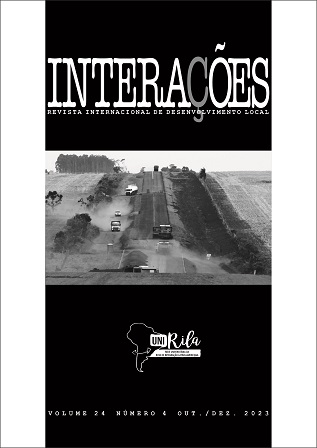The Gastronomic Tourism present in the Bioceanic Route in Mato Grosso do Sul
Keywords:
Bioceanic Road Route, Gastronomic Tourism, Cultural HeritageAbstract
The subject of this article is the possibility of exploring and discovering the potential of the gastronomy in the state of Mato Grosso do Sul, more specifically in the municipalities that make up the Bioceanic Route, aiming to highlight the importance and attractions of gastronomic tourism. Additionally, the intention is to promote the Bioceanic Route as a tourist destination for gastronomy enthusiasts, highlighting the unique foods and gastronomic experiences that can be found along the journey. The analytical trajectory of this work was based on bibliographic review and analysis of documented data from public institutions, with the intention of obtaining updated information and knowledge on the subject. The results obtained indicate that, up to the present moment, there are no financial investments or discussions about the implementation of a gastronomic route along the Bioceanic Route. The route lacks fueling stations, which, once established, tend to offer fast food and ready-made meals for truck drivers who transit through the region, considered a logistics hub. However, one initiative does not invalidate the other, as while it is necessary to provide quick and affordable food to meet the dietary needs of those who transit for work, there is also another audience that will enjoy the route for leisure travel. Therefore, the creation of a gastronomic circuit, which includes restaurants, cafes, local producers, food fairs, and other establishments, offering an authentic experience of the regional cuisine, brings numerous benefits for local development. In summary, the creation of a gastronomic route can be a promising opportunity for sustainable local development, valuing regional cuisine, stimulating tourism, and strengthening the economy. This project requires planning, community involvement, and strategic partnerships to achieve success.
References
ARAÚJO, Wilma M. C.; MONTEBELO, Nancy di Pilla; BOTELHO, Raquel B. A.; BORGO, Luiz Antônio. Alquimia dos alimentos. 3. ed. Brasília: Senac, 2017.
ASATO, Thiago Andrade. A Rota Bioceânica como campo de possibilidades para o
desenvolvimento da atividade turística. 2021. 179 p. Tese (Doutorado em Desenvolvimento Local) – Universidade Católica Dom Bosco, Campo Grande, MS, 2021.
BRILLAT-SAVARIN, Jean Anthelme. A fisiologia do gosto. 2. ed. Tradução de Paulo Neves. São Paulo: Companhia das Letras, 2019. [|Originalmente publicado em 1825].
CASCUDO, Luís da Câmara. História da alimentação no Brasil. 1. ed. São Paulo: Digital Global, 2016.
CONTINI, Adriana; CASTILHO, Maria Augusta; COSTA, Reginaldo Brito. A erva-mate e os Kaiowá e Guarani: da abordagem etnobotânica à promoção do desenvolvimento local. Interações, Campo Grande, MS, v. 13, n. 2, p. 161-8, jul./dez. 2012. Disponível em https://www.interacoes.ucdb.br/interacoes/article/view/311. Acesso em: 17 jul. 2023.
DÓRIA, Carlos Alberto. A formação da culinária brasileira. São Paulo: Publifolha, 2008.
FREIRE, Paulo. A Importância do Ato de Ler. 23. ed. São Paulo: Autores Associados, 1989.
FREYRE, Gilberto. Casa grande & senzala. 51. ed. São Paulo: Global, 2012.
LIMA, Daniela. A história e a cultura mestiça que moldaram a identidade de Campo Grande. Portal da Educativa, Campo Grande, MS, 21 ago. 2017. Disponível em http://www.portaldaeducativa.ms.gov.br/a-historia-e-a-cultura-mestica-que-moldaram-a-identidade-de-campo-grande/. Acesso em: 15 jul. 2023.
PREFEITURA MUNICIPAL DE CAMPO GRANDE (PREFCG). O sobá de Campo Grande da colonização japonesa ao mais típico dos pratos da culinária local. Campo Grande: [s.n.], [s.d.].
RODRIGUES, Tiago S. Com apoio da Prefeitura, 27ª Festa da Linguiça bate recordes, recebe mais de 40 mil pessoas e comercializa 8 toneladas da tradicional iguaria. Portal da Prefeitura Municipal de Maracaju, Maracaju, 3 maio 2023. Disponível em: https://www.maracaju.ms.gov.br/portal/noticias/0/3/6785/com-apoio-da-prefeitura-27-festa-da-linguica-bate-recordes-recebe-mais-de-40-mil-pessoas-e-comercializa-8-toneladas-da-tradicional-iguaria/. Acesso em: 17 jul. 2023.
SAMPAIO, Iracema. Cheiros & sabores: de Mato Grosso do Sul. Campo Grande: Alvorada, 2012.
SOBRINHO, Jeremias. Estrutura das diretrizes da preservação do patrimônio cultural de Porto Murtinho. 2021. 123 f. (Projeto Apoio ao desenvolvimento do Plano diretor de Porto Murtinho). Universidade Federal de Mato Grosso do Sul (UFMS), Campo Grande.
WILKE, Erick Push. Apontamentos sobre o Corredor Bioceânico Brasil-Norte do Chile: economia, logística, direito, história e turismo. Campo Grande: Life Editora, 2022.
Downloads
Published
How to Cite
Issue
Section
License
Copyright (c) 2023 Joelma Fernandes Arguelho, Luana Silva Ponticelli, Caciano Silva Lima, Maria Augusta de Castilho

This work is licensed under a Creative Commons Attribution 4.0 International License.
Direitos Autorais para artigos publicados nesta revista são do autor, com direitos de primeira publicação para a revista. Em virtude de aparecerem nesta revista de acesso público, os artigos são de uso gratuito, com atribuições próprias, em aplicações educacionais e não-comerciais.


